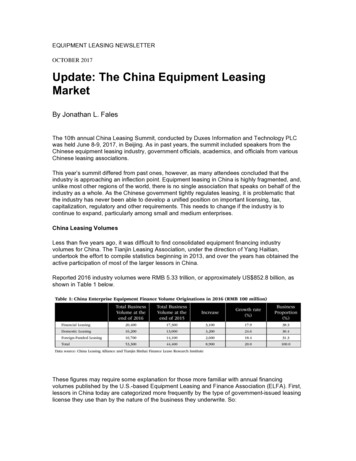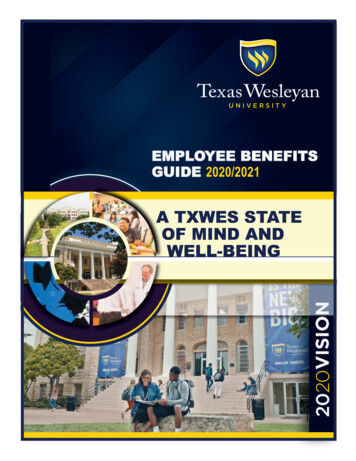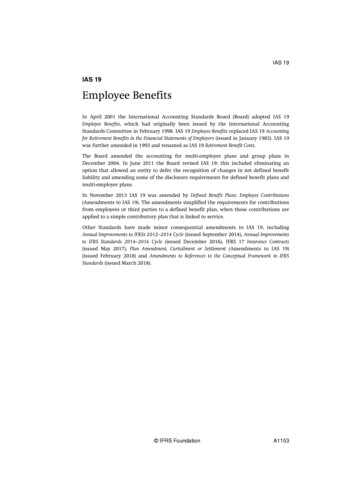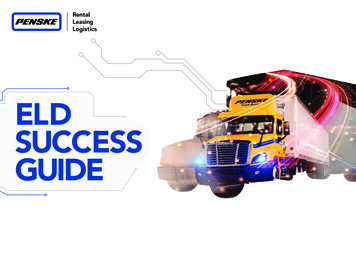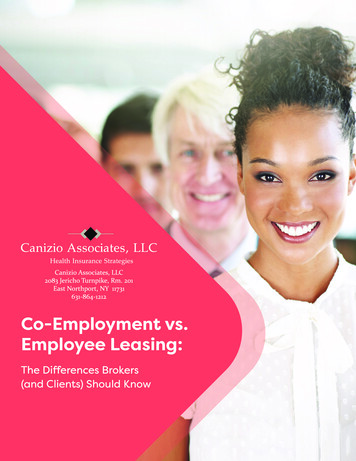
Transcription
Co-Employment vs.Employee Leasing:(and Clients) Should Know
We have written many times about how the PEO industryhas been in a period of continued growth. Due to theincreased awareness of PEOs and the benefits theyprovide to small business clients—and aided by theacknowledgement of the United States governmentthrough the CPEO program—the number of PEOs inexistence grows each year.As the world of HR grows more complex, the benefits a PEO provides to bothbrokers and their clients will continue to expand. Just last year, the NationalAssociation of Professional Employer Organizations (NAPEO) found thesestatistics about the benefits a PEO can bring to a small business client:70%of PEO clientsreported 98of PEO clientswould recommenda PEO to asmall businesscolleagueDespite this exciting industry growth, confusion still exists among some brokersand small business owners, especially around one important aspect of thePEO-client relationship.This stems from the misunderstanding between two very different things:co-employment and employee leasing. The confusion around these termscan cause both brokers and small business owners to hesitate working witha PEO—thinking that this solution means a loss of control over key businessdecisions, and of their employees.However, this is far from the truth. This eBook explores co-employment inmore detail, what it really is, how it works for small business clients, and whyit is very different from employee leasing.2 Co-Employment vs. Employee Leasing: The Differences Brokers (and Clients) Should Know
What Is Co-Employment (And What Is it Not)?Co-employment is the contractualallocation and sharing of certainemployer responsibilities betweenthe PEO and the client.Let’s start by first defining co-employment. NAPEO describesit as “the contractual allocation and sharing of certainemployer responsibilities between the PEO and the client.”As the Administrative Employer, the PEO contractuallyassumes specific responsibilities. The client maintainstheir status as the Worksite Employer—this is significant asthe client retains complete control and direction over theiremployees and all day-to-day operations.Perhaps the biggest misunderstanding about co-employmentis that a PEO supplies workers to their clients. This isn’ttrue—this type of working arrangement is called employeeleasing, not co-employment (more on that shortly).When a small business client enters into a partnershipwith a PEO, the client’s employees become employed bytwo companies: the client company, called the worksiteemployer AND the PEO, the administrative employer.What Does Co-Employment Mean fora PEO Client?Client retains full control overthe hiring, firing, promoting, andany organizational changes totheir workforce.For both brokers and small business owners, the mostimportant thing to know about co-employment is that aclient retains full control over the hiring, firing, promoting,and any organizational changes to their workforce.Clients also maintain complete control over any futurepersonnel decisions that take place after entering intoa partnership with a PEO. The client must notify the PEOwhen a new hire is made so that HR administrative andcompliance reporting is up-to-date. The same goes for anyother changes to employees such as pay changes andpromotions, for example.Some believe that a client will lose control of theirbusiness—from personnel decisions to day-to-dayoperations—if partnering with a PEO and establishing aco-employment arrangement. However, this in inaccurate.As a matter of fact, clients retain full control over all keydecisions involving their workforce.Co-Employment vs. Employee Leasing: The Differences Brokers (and Clients) Should Know 3
Which Responsibilities Fall on the PEO in aCo-Employment Relationship?Upon entering a co-employment relationship, a client’s employees (called worksite employees by the PEO) are employedby two companies: the PEO and the client. Each has their own set of responsibilities that are outlined in the clientservice agreement.Remitting wages and withholdingsof a client’s workforceIssuing Form W-2 for compensationunder the PEO’s EmployerIdentification NumberReporting, collecting, and depositingemployment taxes with federal, state,and local authoritiesWorkers compensation insuranceThe PEO assumescertain administrativeemployer rights,responsibilities, riskand other HRadministrative tasks.Managing the client’s payrollAssisting with risk managementand HR complianceSupplying and coordinating employeebenefit plans Health and vision 401(k) and other savings plans Voluntary and complimentary benefitsIt’s important to note that each PEO-client relationship is unique and can be different based on the agreed roles andresponsibilities for each party. These are outlined and specified in the respective client service agreement.What Doesn’t Happen When Entering Into aCo-Employment Relationship with a PEO?Employee leasing is the practice ofsupplying new workers or contractorsto a client.The most common misconception that surroundsco-employment is that it results in a PEO supplying workersto a client and losing control over its workforce. However, thisisn’t co-employment at all—it’s employee leasing.Also known as a temporary employment arrangement,employee leasing is the practice of supplying new workersor contractors to a client, usually on a temporary basis.Often, employee leasing is for work on a specific projectthat has a start and end date.This type of work arrangement is most often associatedwith staffing organizations, but despite the differences getsincorrectly tied to PEOs and other HR outsourcing companies.Companies that have an employee leasing model provideworkers (known as contractors) to their client who performtheir work at the client’s place of business. Once the project,contract, or time-frame is complete, the worker returns to theleasing company, who is their actual employer.It’s extremely important for brokers and small businessleaders to know that PEOs do not supply workers to theirclients. As we have already mentioned, small businessclients keep their current workforce when entering into aco-employment relationship through a PEO, and have fullcontrol of future hiring and workforce decisions that takeplace after the partnership begins.Please note, many PEOs do offer recruiting services to theirclients, which help clients recruit and hire new employees.However, the client ultimately gets to interview candidates andthe final hiring decision rests solely with the client, not the PEO.4 Co-Employment vs. Employee Leasing: The Differences Brokers (and Clients) Should Know
How Does Co-Employment Differ fromEmployee Leasing?To help clear the air on the misconception that co-employment is employee leasing, we have put together the below graphicthat shows some of the key traits between these two very different working arrangements.Key TraitsCo-Employment Supply staff or contractors to a clientThe sharing of certain employer responsibilitiesAllow clients to retain control over personnel decisionsEmployees are employed by the client Also known as a temporary employment arrangementAssociated with staffing firmsPEO assumes certain employer rights and responsibilitiesAllows the client to hire new employees after the partnership is establishedClient retains control over day-to-day business decisionsClient maintains full control of their businessEmployee Leasing As you can see from this checklist, co-employment and employee leasing differ in many important ways. They each havedifferent outcomes and impacts for a client who enters into one of these arrangements.Knowing these differences and what makes co-employment different from employee leasing (and vice-versa) can helpbrokers and small business clients make the most informed and best decision for their company.Employee leasing can be a valuable resource for companies, and many take advantage of these services to help theirbusiness grow. However, for brokers and small employers who don’t want to lose control of the employee-side of theirbusiness, exploring PEO services and co-employment could prove to be a valuable decision.Co-Employment vs. Employee Leasing: The Differences Brokers (and Clients) Should Know 5
Co-Employment and Employee LeasingAren’t the SameGiven the complexities involved with HR administration andcompliance in today’s business world, both benefits brokersand small business owners can benefit from knowing whatmakes co-employment different from employee leasing.They each have completely different relationships andbusiness outcomes for a client, which are significant.Don’t let the myth that co-employment is employee leasingprevent your business or client from achieving business growthand success. The benefits a PEO (through co-employment)brings to a client are well documented. Ultimately, knowing thedifferences between co-employment and employee leasing canhelp you make a truly informed decision that can have profoundpositive impacts on your business!But the two most important characteristics of co-employmentare that a client maintains full control of their business, andthe PEO doesn’t lease workers to the client company.For More Information: 2021 The Extens is Group LLC . All R ights R es erved.Extens is HR is a regis tered s ervice ma rk of The Exte nsis Group LLC, Woodbridge, NJ 0 7095
Companies that have an employee leasing model provide workers (known as contractors) to their client who perform their work at the client's place of business. Once the project, contract, or time-frame is complete, the worker returns to the leasing company, who is their actual employer.





